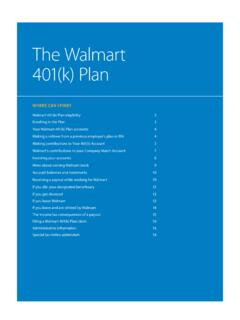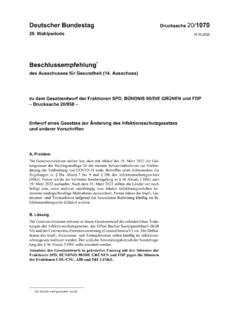Transcription of Guide to Surge Protection Devices - Hager
1 Guide toSurge Protection DevicesThe whole nature of how electrical equipment is used in homes and at work has evolved; with everyday activities relying on electronic equipment. Products such as computers, printers, flat screen televisions, industrial control equipment such as PLC s, alarms, microwaves and washing machines are common place. These can all be vulnerable to transient overvoltages, which can significantly reduce the equipment s lifespan through degradation and Guide expands upon some of the requirements found in the 17th Edition of the IET Wiring Regulations and other standards, related to the Protection of electrical equipment from electrical surges.
2 It considers Protection against voltage transients on the electrical installation only. Consideration should also be given to the Protection against transient overvoltages transmitted by data transmission systems. BS EN 50174 : this Guide does not ensure compliance with BS 7671 or indeed guarantee that equipment is protected against electrical surges. The electrical specifier should use their own judgment, consulting BS 7671 and the BS EN 62305 series ( Protection against lightning) to determine the need and correct selection of Surge Protection associated with electrical surgesPage 4 Terminology and selection criteriaPage 8 Selection of suitable devicesPage 9 ConnectionPage 12 Cascading devicesPage 14 Inspection & TestingPage 16 SPD Quick selection guidePage 17 Guide to | Surge Protection Devices4 Surge protective Devices (SPD)
3 Assist in the Protection of valuable electrical and electronic equipment against transients, originating from lightning and also from switching transients can cause damage ranging from the premature ageing of equipment, logic failures and down time, to the complete destruction of equipment within the entire electrical installation. Products such as LCD screens, data servers and industrial equipment such PLC s are critical to business activity. Protecting this equipment may now be a Hager SPD range of solutions may offer Protection to prevent damage to this sensitive equipment by diverting the damaging transient over-voltages.
4 In the majority of cases this will eliminate equipment failures and reduce choice of a Surge protective device depends upon: The exposure of the building to lightning transients The sensitivity and value of the equipment that requires Protection (it is recommended that the contractor should discuss the installations requirements with the customer) The location and therefore the exposure level of the installation The equipment used within the installation and whether this equipment could generate switching transientsRisks of electrical surgesGuide to | Surge Protection Devices5 Lightning discharges could contain currents of 200,000A which if struck at or near power transmission lines would generate a significant voltage transient.
5 This voltage transient could cause significant damage to both domestic and commercial electronic UK regional map illustrates the likely lightning activity caused by the number of thunderstorm days across the country. Protection against over-voltages is the subject of section 443 of BS 7671. Here the AQ criteria method is introduced which is based on the likelihood of the equipment being subjected to over-voltages caused by lightning strikes, taking account of the probable number of lightning strikes per year.
6 For electrical installations in the UK, the map shows that the probable number of thunderstorm days per year in any given location is less than 25, and therefore condition AQ1 7671 and the AQ criteria method > 1412 to 1410 to 128 to 106 to 84 to 6< 4 Average value (days)Average number of days of thunder during the whole year (1971 to 2000)Map courtesy of the Met OfficeGuide to | Surge Protection Devices6 Where this is the case and for installations being supplied by overhead lines, Regulation indicates that provided the impulse withstand voltage of the equipment is not less than the values given in Table (see Table 1 for installations rated at 230 V to Earth), no additional Protection by a SPD is required.
7 However, where higher levels of equipment reliability or higher risks ( fire) are expected, additional Protection by an SPD against over-voltage may be , for an installation having no overhead lines, no additional Protection against overvoltages is required if the equipment meets the minimum voltage withstand values in table are some words of caution in the notes to this section where it is recognised that transient over-voltages transmitted by the supply distribution system are not significantly attenuated. So an induced voltage some distance away could easily manifest itself at the electrical installation and cause potential harm to the equipment within.
8 It is also worth considering that the AQ data is for thunderstorm days NOT lightning strikes. One storm will usually contain many lightning flashes which could lead to an over-voltage on the installation causing damage to equipment. where higher levels of equipment reliability or higher risks ( fire) are expected, additional Protection by an SPD against over-voltage may be required. Guide to | Surge Protection Devices7 Impulse withstand categoryExample of equipment in category (note 1)Required minimum impulse withstand voltage (note 2)I (low impulse voltage) Sensitive electronic equipment connected to the fixed kVII (normal impulse voltage)Domestic appliances and portable power tools connected to the fixed kVIII (high impulse voltage)
9 Equipment intended to be installed in a part of the fixed installation where a high degree of availability of overvoltages is expected, such as distribution boards, circuit-breakers and wiring kVIV (very high impulse voltage)Equipment intended to be installed at or near the intake to the installation, such as the energy kVTable 1: Required minimum impulse withstand voltage for equipment where installation rated voltage is 230V to Earth (based on tables of BS7671)Notes:1. Table of BS 7671 gives a fuller list of examples of equipment falling into each This table applies only for installations of rated voltage (Uo) 230V.
10 For installations of other rated voltages, see Table of BS to | Surge Protection Devices8 Surge Protection Devices are classified according to their standard into different types Type 1 - SPD which can discharge partial lightning current with a typical waveform 10/350 s. Usually employs spark gap technology. Type 2 - SPD which can prevent the spread of over-voltages in the electrical installations and protects equipment connected to it. It usually employs metal oxide varistor (MOV) technology and is characterized by an 8/20 s current wave.


